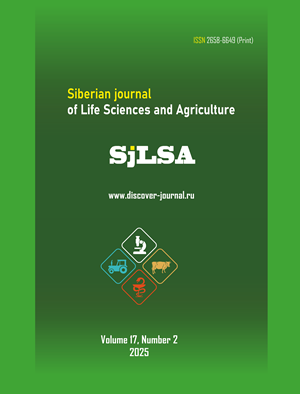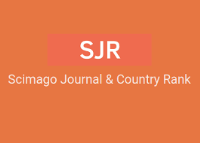Оценка засухоустойчивости сортов и гибридов маслины европейской
Аннотация
Обоснование. Маслина европейская (O. europaea L.) является одной из основных плодовых культур в мире. Наибольшее распространение она получила в Средиземноморском районе. В последние годы из-за глобального потепления и аридизации земли большинство стран-производителей маслины терпят значительные убытки и вынуждены переносить посадки маслины из традиционных южных регионов в более влажные северные. Недостаточные осадки и нехватка поливной воды являются в настоящее время одним из лимитирующих факторов в распространении данной культуры. Производители все чаще ориентируются на посадку засухоустойчивых сортов, которые в условиях недостаточного водоснабжения могли бы давать высокие и регулярные урожаи. В связи с этим, целью настоящего исследования было выделить генотипы O. europaea с высокой адаптационной способностью к засушливым условиям юга России и определить наиболее информативные показатели засухоустойчивости для скрининга коллекции.
Материалы и методы. Исследования показателей водного режима (водоудерживающей способности, водного дефицита, оводненности) и относительный выход электролита при повреждении клеточной мембраны в условиях дегидратации тканей листа проводили на 60 внутривидовых гибридах маслины европейской. Контролем служили сорта Corregiolo и Ascolano.
Эксперименты выполняли в лабораторных условиях при постоянной контролируемой температуре 30°С и относительной влажности воздуха 30%. Оценку показателей засухоустойчивости проводили после насыщения тканей листа водой (контроль), а также после дегидратации таковых в течение 24, 48 и 72 часов.
Результаты. На основании кластерного анализа, проведенного по основным показателям засухоустойчивости выделено четыре основных группы генотипов маслины европейской с различной устойчивостью к засухе. Наибольший интерес представляют гибриды, которые по результатам исследования были включены в группу с очень высокой засухоустойчивостью. Этот кластер включает в себя 14 наиболее перспективных гибридов, которые превосходят по засухоустойчивости контрольный сорт маслины Ascolano. Водопотеря через 72 часа завядания у этих образцов варьировала от 20,81 до 33,63%, а относительный выход электролита – от 0,27 до 0,36 отн. ед., что позволяет сделать вывод об очень высокой их засухоустойчивости. На основе анализа главных компонент между различными критериями водного режима растений маслины была показана взаимосвязь, и влияние на интегральную оценку засухоустойчивости. Отмечено, что наиболее информативным показателем, имеющим отрицательную корреляцию с водопотерей и относительным выходом электролита при повреждении клеточной мембраны, является водоудерживающая способность. Такие показатели-индикаторы засухоустойчивости как содержание воды в листьях, водный дефицит и относительное содержание воды в листьях оказались недостаточно информативны для отбора засухоустойчивых сортов и форм маслины.
Информация о спонсорстве. Исследование выполнено за счет средств гранта Российского научного фонда № 24-26-00066 на базе Уникальной научной установки «ФИТОБИОГЕН» и ЦКП «Физиолого-биохимические методы исследования растительных объектов».
EDN: HAMDEP
Скачивания
Литература
Государственный реестр селекционных достижений, допущенных к использованию. Реестр селекционных достижений. URL: https://gossortrf.ru/registry/gosudarstvennyy-reestr-selektsionnykh-dostizheniy-dopushchennykh-k-ispolzovaniyu-tom-2-porody-zhivot/ (дата обращения: 08.08.2024).
Корсакова, С. П., & Корсаков, П. Б. (2020). Климатическая характеристика сезонов 2019 г. на Южном берегу Крыма. Научные записки природного заповедника «Мыс Мартьян», (11), 6-22. https://doi.org/10.36305/2413-3019-2020-11-06-22 EDN: https://elibrary.ru/ikwwkn
Лищук, А. И. (1991). Методика определения водоудерживающей способности к обезвоживанию листьев плодовых культур. В: Физиологические и биофизические методы в селекции плодовых культур: Методические рекомендации (с. 33-36). Москва.
Постановление Правительства РФ от 13 мая 2022 г. N 872 «О внесении изменений в постановление Правительства Российской Федерации от 25 августа 2017 г. N 996» [Электронный ресурс] // base.garant.ru: официальный сайт. URL: https://base.garant.ru/404734015/ (дата обращения: 13.08.2024).
Самигуллина, Н. С. (2006). Практикум по селекции и сортоведению плодовых и ягодных культур: учебное издание. Мичуринск: Издательство Мичуринского государственного аграрного университета. 197 с.
Abdallah, M. B., Trupiano, D., Polzella, A., De Zio, E., Sassi, M., Scaloni, A., Zarrouk, M., Youssef, B., & Scippa, G. S. (2018). Unraveling physiological, biochemical and molecular mechanisms involved in olive (Olea europaea L. cv. Chétoui) tolerance to drought and salt stresses. Journal of Plant Physiology, 220, 83-95.
Ahmadipour, S., Arji, I., Ebadi, A., & Abdossi, V. (2018). Physiological and biochemical responses of some olive cultivars (Olea europaea L.) to water stress. Cellular and Molecular Biology, 64(15), 20-29. https://doi.org/10.14715/cmb/2017.64.15.4
Ahmed, C. B., Rouina, B. B., & Boukhris, M. (2007). Effects of water deficit on olive trees cv. Chemlali under field conditions in arid region in Tunisia. Scientia Horticulturae, 113(3), 267-277. https://doi.org/10.1016/j.scienta.2007.03.020
Araujo, M., Prada, J., Mariz-Ponte, N., Santos, C., Pereira, J. A., Pinto, D. C. G. A., Silva, A. M. S., & Dias, M. C. (2021). Antioxidant adjustments of olive trees (Olea europaea) under field stress conditions. Plants, 10(4), 684. https://doi.org/10.3390/plants10040684 EDN: https://elibrary.ru/vgimhc
Arias, N. S., Scholz, F. G., Goldstein, G., & Bucci, S. J. (2021). Low-temperature acclimation and legacy effects of summer water deficits in olive freezing resistance. Tree Physiology, 41(10), 1836-1847. https://doi.org/10.1093/treephys/tpab040 EDN: https://elibrary.ru/rkchei
Ayaz, M., Varol, N., & Yolcu, S. (2021). Three (Turkish) olive cultivars display contrasting salt stress-coping mechanisms under high salinity. Trees, 35, 1283-1298. https://doi.org/10.1007/s00468-021-02115-w EDN: https://elibrary.ru/knukeu
Bacelar, E. A., Moutinho-Pereira, J. M., Gonçalves, B. C., Ferreira, H. F., & Correia, C. M. (2007). Changes in growth, gas exchange, xylem hydraulic properties and water use efficiency of three olive cultivars under contrasting water availability regimes. Environmental and Experimental Botany, (60), 183-192.
Barranco, D., Fernandez-Escobar, R., & Rallo, L. (2010). Olive Growing. Mundi-Prensa: Junta de Andalucía, Australian Olive Association Ltd. 756 p.
Bosabalidis, A. M., & Kofidis, G. (2002). Comparative effects of drought stress on leaf anatomy of two olive cultivars. Plant Science, 163(2), 375-379. https://doi.org/10.1016/S0168-9452(02)00135-8 EDN: https://elibrary.ru/bbaieu
Brito, C., Dinis, L.-T., Silva, E., Gonçalves, A., Matos, C., Rodrigues, M. A., Moutinho-Pereira, J., Barros, A., & Correia, C. (2018). Kaolin and salicylic acid foliar application modulate yield, quality and phytochemical composition of olive pulp and oil from rainfed trees. Scientia Horticulturae, (237), 176-183.
Carr, M. K. V. (2013). The water relations and irrigation requirements of olive (Olea europaea L.): A review. Experimental Agriculture, 49(4), 597-639. https://doi.org/10.1017/S0014479713000276
Connor, D. J. (2005). Adaptation of olive (Olea europaea L.) to water-limited environments. Australian Journal of Agricultural Research, 56(11), 1181-1189. https://doi.org/10.1071/AR05169
Denaxa, N. K., Damvakaris, T., & Roussos, P. A. (2020). Antioxidant defense system in young olive plants against drought stress and mitigation of adverse effects through external application of alleviating products. Scientia Horticulturae, (259), 108812. https://doi.org/10.1016/j.scienta.2019.108812 EDN: https://elibrary.ru/kxmzvc
Deslauriers, A., Caron, L., & Rossi, S. (2015). Carbon allocation during defoliation: testing a defense-growth trade-off in balsam fir. Frontiers in Plant Science, 6, 338.
Dias, M. C., Correia, S., Serodio, J., Silva, A. M. S., Freitas, H., & Santos, C. (2018). Chlorophyll fluorescence and oxidative stress endpoints to discriminate olive cultivars tolerance to drought and heat episodes. Scientia Horticulturae, 231, 31-35. https://doi.org/10.1016/j.scienta.2017.12.007 EDN: https://elibrary.ru/yexjid
Faraloni, C., Cutino, I., Petruccelli, R., Leva, A. R., Lazzeri, S., & Torzillo, G. (2011). Chlorophyll fluorescence technique as a rapid tool for in vitro screening of olive cultivars (Olea europaea L.) tolerant to drought stress. Environmental and Experimental Botany, 73, 49-56. https://doi.org/10.1016/j.envexpbot.2010.10.011 EDN: https://elibrary.ru/pmzbfb
Food and Agriculture Organization of the United Nations (2021). Global Outlook on Climate Services in Agriculture: Investment Opportunities to Reach the Last Mile. Rome, Italy: Food & Agriculture Org. ISBN: 978-92-5-135011-9
Food and Agriculture Organization of the United Nations, FAOSTAT [Electronic resource] // Available online: URL: https://www.fao.org/faostat/en/#data/QCL/visualize (accessed on 23 December 2023).
Gambella, F., Bianchini, L., Cecchini, M., Egidi, G., Ferrara, A., Salvati, L., Colantoni, A., & Morea, D. (2021). Moving toward the north? The spatial shift of olive groves in Italy. Agricultural Economics, 67(4), 129-135. https://doi.org/10.17221/467/2020-AGRICECON EDN: https://elibrary.ru/mejiyc
Gucci, R., Lombardini, L., & Tattini, M. (1997). Analysis of leaf water relations in leaves of two olive (Olea europaea) cultivars differing in tolerance to salinity. Tree Physiology, 17(1), 13-21.
Guerfel, M., Baccouri, O., Boujnah, D., Chaïbi, W., & Zarrouk, M. (2009). Impacts of water stress on gas exchange, water relations, chlorophyll content and leaf structure in the two main Tunisian olive (Olea europaea L.) cultivars. Scientia Horticulturae, 119(3), 257-263. https://doi.org/10.1016/j.scienta.2008.08.006 EDN: https://elibrary.ru/yarjez
Gul, N., Haq, Z. U., Ali, H., Munsif, F., Hassan, S. S. U., & Bungau, S. (2022). Melatonin Pretreatment Alleviated Inhibitory Effects of Drought Stress by Enhancing Anti-Oxidant Activities and Accumulation of Higher Proline and Plant Pigments and Improving Maize Productivity. Agronomy, 12(10), 2398. https://doi.org/10.3390/agronomy12102398 EDN: https://elibrary.ru/padsde
Hammer, G. M., Cooper, M., & Reynolds, M. P. (2021). Plant production in water-limited environments. Journal of Experimental Botany, 72(14), 5097-5101. https://doi.org/10.1093/jxb/erab273 EDN: https://elibrary.ru/zivrhc
Hammer, Ø., & Harper, D. A. T. (2001). PAST: paleontological statistics software package for education and data analysis. Palaeontological Electronica, 4, 4. URL: http://palaeo-electronica.org/2001_1/past/issue1_01.htm
Islam, M. S., Hasan, K., Islam, R., Chowdhury, K., Pramanik, M. H., Iqbal, M. A., Rajendran, K., Iqbal, R., Soufan, W., Kamran, M., & Islam, M. S. (2023). Water relations and yield characteristics of mungbean as influenced by foliar application of gibberellic acid (GA3). Frontiers in Ecology and Evolution, 11, 1048768. https://doi.org/10.3389/fevo.2023.1048768 EDN: https://elibrary.ru/qavfis
Larcher, W. (2003). Physiological Plant Ecology. 4th ed. Heidelberg/Berlin, Germany; New York, NY, USA: Springer-Verlag. 164 p.
Larsen, F. E., Higgins, S. S., & Al Wir, A. (1989). Diurnal water relations of apple, apricot, grape, olive and peach in an arid environment (Jordan). Scientia Horticulturae, 39(3), 211-222.
Liu, H., Na, H. E., Li, Y. J., Ning, D. L., Ting, M. A., & Xiao, L. J. (2013). Evaluation on drought stress tolerance of six olive varieties cultivated in Yunnan. Journal of West China Forestry Science, 42, 107-110.
Martin-Palomo, M. J., Andreu, L., Perez-Lopez, D., Centeno, A., Galindo, A., Moriana, A., & Corell, M. (2022). Trunk growth rate frequencies as water stress indicator in almond trees. Agricultural Water Management, 271, 107765. https://doi.org/10.1016/j.agwat.2022.107765 EDN: https://elibrary.ru/batbay
Munns, R., & Tester, M. (2008). Mechanisms of salinity tolerance. Annual Review of Plant Biology, 59(1), 651-681. https://doi.org/10.1146/annurev.arplant.59.032607.092911 EDN: https://elibrary.ru/mlwiix
Murzabulatova, F. K., & Zhigunov, O. Yu. (2019). Features of water regime of some species of Deutzia Thumb. genus in the South-Ural Botanical Garden (Ufa). Bulletin of the State Nikit Botanical Garden, (130), 137-140. https://doi.org/10.25684/NBG.boolt.130.2019.19 EDN: https://elibrary.ru/igsgfd
Nguyen, T. C., Jo, H., Tran, H. A., Lee, J., Lee, J.-D., Kim, J. H., Seo, H. S., & Song, J. T. (2024). Assessment of drought responses of wild soybean accessions at different growth stages. Agronomy, 14(3), 471. https://doi.org/10.3390/agronomy14030471 EDN: https://elibrary.ru/teqyzu
Parri, S., Romi, M., Hoshika, Y., Giovannelli, A., Dias, M. C., Piritore, F. C., Cai, G., & Cantini, C. (2023). Morpho-physiological responses of three Italian olive tree (Olea europaea L.) cultivars to drought stress. Horticulturae, 9(7), 830. https://doi.org/10.3390/horticulturae9070830 EDN: https://elibrary.ru/wbwotr
Parry, K. L., Canziani, O. F., Palutikof, J. P., van der Linden, P. J., & Hanson, C. E. (2007). Climate Change 2007: Impacts, Adaptation and Vulnerability. Cambridge, UK: Cambridge University Press. 22 p.
Petridis, A., Therios, I., Samouris, G., Koundouras, S., & Giannakoula, A. (2012). Effect of water deficit on leaf phenolic composition, gas exchange, oxidative damage and antioxidant activity of four Greek olive (Olea europaea L.) cultivars. Plant Physiol. Biochem., (60), 1-11.
Proietti, P., Nasini, L., Del Buono, D., D’Amato, R., Tedeschini, E., & Businelli, D. (2013). Selenium protects olive (Olea europaea L.) from drought stress. Scientia Horticulturae, 164, 165-171. https://doi.org/10.1016/j.scienta.2013.09.034 ISSN 0304-4238
Rallo, L., Diez, C. M., Morales-Sillero, A., Miho, H., Priego-Capote, F., & Rallo, P. (2018). Quality of olives: A focus on agricultural preharvest factors. Sci. Hortic., 233, 491-509. https://doi.org/10.1016/j.scienta.2017.12.034
Rezaei, M., & Rohani, A. (2023). Estimating Freezing Injury on Olive Trees: A Comparative Study of Computing Models Based on Electrolyte Leakage and Tetrazolium Tests. Agriculture, 13, 1137. https://doi.org/10.3390/agriculture13061137 EDN: https://elibrary.ru/yneacx
Slobodova, N., Sharko, F., Gladysheva-Azgari, M., Petrova, K., Tsiupka, S., Tsiupka, V., Boulygina, E., Rastorguev, S., & Tsygankova, S. (2023). Genetic Diversity of Common Olive (Olea europaea L.) Cultivars from Nikita Botanical Gardens Collection Revealed Using RAD-Seq Method. Genes, 14(7), 1323. https://doi.org/10.3390/genes14071323 EDN: https://elibrary.ru/qejysj
Tanentzap, F. M., Stempel, A., & Ryser, P. (2015). Reliability of leaf relative water content (RWC) measurements after storage: consequences for in situ measurements. Botany, 93(9), 535-541. https://doi.org/10.1139/CJB-2015-0065
The International Olive Council [Электронный ресурс]. URL: https://www.internationaloliveoil.org/ (дата обращения: 05.08.2024)
Torres-Ruiz, J. M., Diaz-Espejo, A., Morales-Sillero, A., Martin-Palomo, M. J., Mayr, S., Beikircher, B., & Fernandez, J. E. (2013). Shoot hydraulic characteristics, plant water status and stomatal response in olive trees under different soil water conditions. Plant and Soil, 373, 77-87. https://doi.org/10.1007/s11104-013-1774-1 EDN: https://elibrary.ru/vavnxg
Tsiupka, S. (2018). A historical review of olive germplasm evaluation and cultivar development in Crimea. Acta Hortic., 1208, 97-104. https://doi.org/10.17660/ActaHortic.2018.1208.13 EDN: https://elibrary.ru/valebr
Tsiupka, V., Tsiupka, S., Plugatar, Y., Bulavin, I., & Komar-Tyomnaya, L. (2023). Assessment of the Drought-Tolerance Criteria for Screening Peach Cultivars. Horticulturae, 9, 1045. https://doi.org/10.3390/horticulturae9091045 EDN: https://elibrary.ru/imtmbp
References
State Register of Selection Achievements Allowed for Use. Registry of Selection Achievements. URL: https://gossortrf.ru/registry/gosudarstvennyy-reestr-selektsionnykh-dostizheniy-dopushchennykh-k-ispolzovaniyu-tom-2-porody-zhivot/ (accessed August 8, 2024).
Korсакova, S.P., & Korsakov, P.B. (2020). Climate Characteristics of Seasons in 2019 on the Southern Coast of Crimea. Natural Notes of Martyan Cape Nature Reserve, (11), 6-22. https://doi.org/10.36305/2413-3019-2020-11-06-22 EDN: https://elibrary.ru/ikwwkn
Lischuk, A.I. (1991). Method for Determining Water Retention Capacity During Leaf Dehydration in Fruit Crops. In: Physiological and Biophysical Methods in Fruit Crop Breeding: Guidelines (pp. 33-36). Moscow.
Resolution of the Government of the Russian Federation No. 872 of May 13, 2022 "On Amending Resolution No. 996 of the Government of the Russian Federation of August 25, 2017". URL: https://base.garant.ru/404734015 (accessed August 13, 2024).
Samigullina, N.S. (2006). Practicum on Selection and Sorting of Fruit and Berry Crops: Textbook Edition. Michurinsk: Publishing House of Michurinsky State Agrarian University. 197 p.
Abdallah, M. B., Trupiano, D., Polzella, A., De Zio, E., Sassi, M., Scaloni, A., Zarrouk, M., Youssef, B., & Scippa, G. S. (2018). Unraveling physiological, biochemical and molecular mechanisms involved in olive (Olea europaea L. cv. Chétoui) tolerance to drought and salt stresses. Journal of Plant Physiology, 220, 83-95.
Ahmadipour, S., Arji, I., Ebadi, A., & Abdossi, V. (2018). Physiological and biochemical responses of some olive cultivars (Olea europaea L.) to water stress. Cellular and Molecular Biology, 64(15), 20-29. https://doi.org/10.14715/cmb/2017.64.15.4
Ahmed, C. B., Rouina, B. B., & Boukhris, M. (2007). Effects of water deficit on olive trees cv. Chemlali under field conditions in arid region in Tunisia. Scientia Horticulturae, 113(3), 267-277. https://doi.org/10.1016/j.scienta.2007.03.020
Araujo, M., Prada, J., Mariz-Ponte, N., Santos, C., Pereira, J. A., Pinto, D. C. G. A., Silva, A. M. S., & Dias, M. C. (2021). Antioxidant adjustments of olive trees (Olea europaea) under field stress conditions. Plants, 10(4), 684. https://doi.org/10.3390/plants10040684 EDN: https://elibrary.ru/vgimhc
Arias, N. S., Scholz, F. G., Goldstein, G., & Bucci, S. J. (2021). Low-temperature acclimation and legacy effects of summer water deficits in olive freezing resistance. Tree Physiology, 41(10), 1836-1847. https://doi.org/10.1093/treephys/tpab040 EDN: https://elibrary.ru/rkchei
Ayaz, M., Varol, N., & Yolcu, S. (2021). Three (Turkish) olive cultivars display contrasting salt stress-coping mechanisms under high salinity. Trees, 35, 1283-1298. https://doi.org/10.1007/s00468-021-02115-w EDN: https://elibrary.ru/knukeu
Bacelar, E. A., Moutinho-Pereira, J. M., Gonçalves, B. C., Ferreira, H. F., & Correia, C. M. (2007). Changes in growth, gas exchange, xylem hydraulic properties and water use efficiency of three olive cultivars under contrasting water availability regimes. Environmental and Experimental Botany, (60), 183-192.
Barranco, D., Fernandez-Escobar, R., & Rallo, L. (2010). Olive Growing. Mundi-Prensa: Junta de Andalucía, Australian Olive Association Ltd. 756 p.
Bosabalidis, A. M., & Kofidis, G. (2002). Comparative effects of drought stress on leaf anatomy of two olive cultivars. Plant Science, 163(2), 375-379. https://doi.org/10.1016/S0168-9452(02)00135-8 EDN: https://elibrary.ru/bbaieu
Brito, C., Dinis, L.-T., Silva, E., Gonçalves, A., Matos, C., Rodrigues, M. A., Moutinho-Pereira, J., Barros, A., & Correia, C. (2018). Kaolin and salicylic acid foliar application modulate yield, quality and phytochemical composition of olive pulp and oil from rainfed trees. Scientia Horticulturae, (237), 176-183.
Carr, M. K. V. (2013). The water relations and irrigation requirements of olive (Olea europaea L.): A review. Experimental Agriculture, 49(4), 597-639. https://doi.org/10.1017/S0014479713000276
Connor, D. J. (2005). Adaptation of olive (Olea europaea L.) to water-limited environments. Australian Journal of Agricultural Research, 56(11), 1181-1189. https://doi.org/10.1071/AR05169
Denaxa, N. K., Damvakaris, T., & Roussos, P. A. (2020). Antioxidant defense system in young olive plants against drought stress and mitigation of adverse effects through external application of alleviating products. Scientia Horticulturae, (259), 108812. https://doi.org/10.1016/j.scienta.2019.108812 EDN: https://elibrary.ru/kxmzvc
Deslauriers, A., Caron, L., & Rossi, S. (2015). Carbon allocation during defoliation: testing a defense-growth trade-off in balsam fir. Frontiers in Plant Science, 6, 338.
Dias, M. C., Correia, S., Serodio, J., Silva, A. M. S., Freitas, H., & Santos, C. (2018). Chlorophyll fluorescence and oxidative stress endpoints to discriminate olive cultivars tolerance to drought and heat episodes. Scientia Horticulturae, 231, 31-35. https://doi.org/10.1016/j.scienta.2017.12.007 EDN: https://elibrary.ru/yexjid
Faraloni, C., Cutino, I., Petruccelli, R., Leva, A. R., Lazzeri, S., & Torzillo, G. (2011). Chlorophyll fluorescence technique as a rapid tool for in vitro screening of olive cultivars (Olea europaea L.) tolerant to drought stress. Environmental and Experimental Botany, 73, 49-56. https://doi.org/10.1016/j.envexpbot.2010.10.011 EDN: https://elibrary.ru/pmzbfb
Food and Agriculture Organization of the United Nations (2021). Global Outlook on Climate Services in Agriculture: Investment Opportunities to Reach the Last Mile. Rome, Italy: Food & Agriculture Org. ISBN: 978-92-5-135011-9
Food and Agriculture Organization of the United Nations, FAOSTAT [Electronic resource] // Available online: URL: https://www.fao.org/faostat/en/#data/QCL/visualize (accessed on 23 December 2023).
Gambella, F., Bianchini, L., Cecchini, M., Egidi, G., Ferrara, A., Salvati, L., Colantoni, A., & Morea, D. (2021). Moving toward the north? The spatial shift of olive groves in Italy. Agricultural Economics, 67(4), 129-135. https://doi.org/10.17221/467/2020-AGRICECON EDN: https://elibrary.ru/mejiyc
Gucci, R., Lombardini, L., & Tattini, M. (1997). Analysis of leaf water relations in leaves of two olive (Olea europaea) cultivars differing in tolerance to salinity. Tree Physiology, 17(1), 13-21.
Guerfel, M., Baccouri, O., Boujnah, D., Chaïbi, W., & Zarrouk, M. (2009). Impacts of water stress on gas exchange, water relations, chlorophyll content and leaf structure in the two main Tunisian olive (Olea europaea L.) cultivars. Scientia Horticulturae, 119(3), 257-263. https://doi.org/10.1016/j.scienta.2008.08.006 EDN: https://elibrary.ru/yarjez
Gul, N., Haq, Z. U., Ali, H., Munsif, F., Hassan, S. S. U., & Bungau, S. (2022). Melatonin Pretreatment Alleviated Inhibitory Effects of Drought Stress by Enhancing Anti-Oxidant Activities and Accumulation of Higher Proline and Plant Pigments and Improving Maize Productivity. Agronomy, 12(10), 2398. https://doi.org/10.3390/agronomy12102398 EDN: https://elibrary.ru/padsde
Hammer, G. M., Cooper, M., & Reynolds, M. P. (2021). Plant production in water-limited environments. Journal of Experimental Botany, 72(14), 5097-5101. https://doi.org/10.1093/jxb/erab273 EDN: https://elibrary.ru/zivrhc
Hammer, Ø., & Harper, D. A. T. (2001). PAST: paleontological statistics software package for education and data analysis. Palaeontological Electronica, 4, 4. URL: http://palaeo-electronica.org/2001_1/past/issue1_01.htm
Islam, M. S., Hasan, K., Islam, R., Chowdhury, K., Pramanik, M. H., Iqbal, M. A., Rajendran, K., Iqbal, R., Soufan, W., Kamran, M., & Islam, M. S. (2023). Water relations and yield characteristics of mungbean as influenced by foliar application of gibberellic acid (GA3). Frontiers in Ecology and Evolution, 11, 1048768. https://doi.org/10.3389/fevo.2023.1048768 EDN: https://elibrary.ru/qavfis
Larcher, W. (2003). Physiological Plant Ecology. 4th ed. Heidelberg/Berlin, Germany; New York, NY, USA: Springer-Verlag. 164 p.
Larsen, F. E., Higgins, S. S., & Al Wir, A. (1989). Diurnal water relations of apple, apricot, grape, olive and peach in an arid environment (Jordan). Scientia Horticulturae, 39(3), 211-222.
Liu, H., Na, H. E., Li, Y. J., Ning, D. L., Ting, M. A., & Xiao, L. J. (2013). Evaluation on drought stress tolerance of six olive varieties cultivated in Yunnan. Journal of West China Forestry Science, 42, 107-110.
Martin-Palomo, M. J., Andreu, L., Perez-Lopez, D., Centeno, A., Galindo, A., Moriana, A., & Corell, M. (2022). Trunk growth rate frequencies as water stress indicator in almond trees. Agricultural Water Management, 271, 107765. https://doi.org/10.1016/j.agwat.2022.107765 EDN: https://elibrary.ru/batbay
Munns, R., & Tester, M. (2008). Mechanisms of salinity tolerance. Annual Review of Plant Biology, 59(1), 651-681. https://doi.org/10.1146/annurev.arplant.59.032607.092911 EDN: https://elibrary.ru/mlwiix
Murzabulatova, F. K., & Zhigunov, O. Yu. (2019). Features of water regime of some species of Deutzia Thumb. genus in the South-Ural Botanical Garden (Ufa). Bulletin of the State Nikit Botanical Garden, (130), 137-140. https://doi.org/10.25684/NBG.boolt.130.2019.19 EDN: https://elibrary.ru/igsgfd
Nguyen, T. C., Jo, H., Tran, H. A., Lee, J., Lee, J.-D., Kim, J. H., Seo, H. S., & Song, J. T. (2024). Assessment of drought responses of wild soybean accessions at different growth stages. Agronomy, 14(3), 471. https://doi.org/10.3390/agronomy14030471 EDN: https://elibrary.ru/teqyzu
Parri, S., Romi, M., Hoshika, Y., Giovannelli, A., Dias, M. C., Piritore, F. C., Cai, G., & Cantini, C. (2023). Morpho-physiological responses of three Italian olive tree (Olea europaea L.) cultivars to drought stress. Horticulturae, 9(7), 830. https://doi.org/10.3390/horticulturae9070830 EDN: https://elibrary.ru/wbwotr
Parry, K. L., Canziani, O. F., Palutikof, J. P., van der Linden, P. J., & Hanson, C. E. (2007). Climate Change 2007: Impacts, Adaptation and Vulnerability. Cambridge, UK: Cambridge University Press. 22 p.
Petridis, A., Therios, I., Samouris, G., Koundouras, S., & Giannakoula, A. (2012). Effect of water deficit on leaf phenolic composition, gas exchange, oxidative damage and antioxidant activity of four Greek olive (Olea europaea L.) cultivars. Plant Physiol. Biochem., (60), 1-11.
Proietti, P., Nasini, L., Del Buono, D., D’Amato, R., Tedeschini, E., & Businelli, D. (2013). Selenium protects olive (Olea europaea L.) from drought stress. Scientia Horticulturae, 164, 165-171. https://doi.org/10.1016/j.scienta.2013.09.034 ISSN 0304-4238
Rallo, L., Diez, C. M., Morales-Sillero, A., Miho, H., Priego-Capote, F., & Rallo, P. (2018). Quality of olives: A focus on agricultural preharvest factors. Sci. Hortic., 233, 491-509. https://doi.org/10.1016/j.scienta.2017.12.034
Rezaei, M., & Rohani, A. (2023). Estimating Freezing Injury on Olive Trees: A Comparative Study of Computing Models Based on Electrolyte Leakage and Tetrazolium Tests. Agriculture, 13, 1137. https://doi.org/10.3390/agriculture13061137 EDN: https://elibrary.ru/yneacx
Slobodova, N., Sharko, F., Gladysheva-Azgari, M., Petrova, K., Tsiupka, S., Tsiupka, V., Boulygina, E., Rastorguev, S., & Tsygankova, S. (2023). Genetic Diversity of Common Olive (Olea europaea L.) Cultivars from Nikita Botanical Gardens Collection Revealed Using RAD-Seq Method. Genes, 14(7), 1323. https://doi.org/10.3390/genes14071323 EDN: https://elibrary.ru/qejysj
Tanentzap, F. M., Stempel, A., & Ryser, P. (2015). Reliability of leaf relative water content (RWC) measurements after storage: consequences for in situ measurements. Botany, 93(9), 535-541. https://doi.org/10.1139/CJB-2015-0065
The International Olive Council [Электронный ресурс]. URL: https://www.internationaloliveoil.org/ (дата обращения: 05.08.2024)
Torres-Ruiz, J. M., Diaz-Espejo, A., Morales-Sillero, A., Martin-Palomo, M. J., Mayr, S., Beikircher, B., & Fernandez, J. E. (2013). Shoot hydraulic characteristics, plant water status and stomatal response in olive trees under different soil water conditions. Plant and Soil, 373, 77-87. https://doi.org/10.1007/s11104-013-1774-1 EDN: https://elibrary.ru/vavnxg
Tsiupka, S. (2018). A historical review of olive germplasm evaluation and cultivar development in Crimea. Acta Hortic., 1208, 97-104. https://doi.org/10.17660/ActaHortic.2018.1208.13 EDN: https://elibrary.ru/valebr
Tsiupka, V., Tsiupka, S., Plugatar, Y., Bulavin, I., & Komar-Tyomnaya, L. (2023). Assessment of the Drought-Tolerance Criteria for Screening Peach Cultivars. Horticulturae, 9, 1045. https://doi.org/10.3390/horticulturae9091045 EDN: https://elibrary.ru/imtmbp
Copyright (c) 2025 Sergei Yu. Tsiupka, Yuri V. Plugatar, Valentina A. Tsiupka, Iliya V. Bulavin

Это произведение доступно по лицензии Creative Commons «Attribution-NonCommercial-NoDerivatives» («Атрибуция — Некоммерческое использование — Без производных произведений») 4.0 Всемирная.

























































